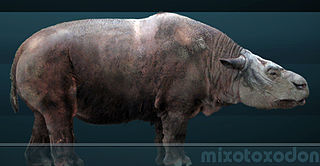
Almodóvar del Campo is a municipality of Spain, located in the province of Ciudad Real, autonomous community of Castilla–La Mancha. Featuring a total area of 1.208,25 km2, it is the largest municipality in the region and one of the largest municipalities in Spain. As of 1 January 2020, it had a population of 5,983.

Puertollano is a municipality of Spain located in the province of Ciudad Real, Castile-La Mancha. The city has a population of 45,539 (2022). Contrasting to the largely rural character of the region, Puertollano stands out for the importance of industry, with a past linked to industrial and mining activities. It lies on the AVE high-speed train line linking Madrid and Seville.

Aragosaurus was a genus of sauropod dinosaur from the Early Cretaceous period of Galve, province of Teruel, in the autonomous territory of Aragón, Spain. It was deposited in the Villar del Arzobispo Formation.

Zonitoides is a genus of air-breathing land snails, terrestrial gastropod mollusks in the family Gastrodontidae.
Julián Ribera y Tarragó was a Spanish Arabist and academic.

Mixotoxodon is an extinct genus of notoungulate of the family Toxodontidae inhabiting South America, Central America and parts of southern North America during the Pleistocene epoch, from 1,800,000—12,000 years ago.

The North Andes Plate or North Andes Block is a small tectonic plate (microplate) located in the northern Andes. It is squeezed between the faster moving South American Plate and the Nazca Plate to the southwest. Due to the subduction of the Malpelo and Coiba Plates, this area is very prone to volcanic and seismic activity, with many historic earthquakes.

The Camarillas Formation is a geological formation in the Teruel Province of Aragón, Spain whose strata date back to the Early Cretaceous. The sandstones, mudstones and conglomerates of the formation, that due to syn-sedimentary faulting varies greatly in thickness from 300 to 800 metres, were deposited in fluvial, deltaic and lacustrine environments.
Manuel Santillán Osorno was a Mexican geological engineer and politician.
The Villar del Arzobispo Formation is a Late Jurassic to possibly Early Cretaceous geologic formation in eastern Spain. It is equivalent in age to the Lourinhã Formation of Portugal. It was originally thought to date from the Late Tithonian-Middle Berriasian, but more recent work suggests a Kimmeridigan-Late Tithonian, possibly dating to the Early Berriasian in some areas. The Villar del Arzobispo Formation's age in the area of Riodeva in Spain has been dated based on stratigraphic correlations as middle-upper Tithonian, approximately 145-141 million years old. In the area of Galve, the formation potentially dates into the earliest Cretaceous.

The La Pedrera de Rúbies Formation is an Early Cretaceous (late Berriasian to early Barremian geologic formation in Catalonia, Spain. The formation crops out in the area of the Montsec in the Organyà Basin. At the La Pedrera de Meià locality, the formation consists of rhythmically laminated, lithographic limestones that formed in the distal areas of a large, shallow coastal lake. It is noted for the exceptional preservation of articulated small vertebrates and insects, similar to that of the Solnhofen Limestone.

Stenorhynchosaurus is an extinct genus of pliosaurid plesiosaurs which lived in the Early Cretaceous of South America. The type species and only known is Stenorhynchosaurus munozi. It was a medium-sized pliosaur, reaching an adult body length of 7 m (23 ft).

The Honda Group is a geological group of the Upper and Middle Magdalena Basins and the adjacent Central and Eastern Ranges of the Colombian Andes. The group, in older literature also defined as formation, is in its present-day type section in the Tatacoa Desert in the department of Huila subdivided into two main formations; La Victoria and Villavieja.
María Dolores Soria Mayor, also known as Loli Soria, was a Spanish paleontologist.
Asunción Linares Rodríguez was a Spanish paleontologist who excelled in teaching and research. She earned a degree in Natural Sciences at the Complutense University of Madrid, obtaining her doctorate in 1952 under the direction of Bermudo Meléndez. She became the Chair of Paleontology at the University of Granada in 1961, being the first woman to obtain such a position on a science faculty in Spain, and the second to become a full professor after the Civil War. Regarding her academic relevance, she stood out for the direction of numerous doctoral works over her career.

The Colombian Geological Survey (CGS) is a scientific agency of the Colombian government in charge of contributing to the socioeconomic development of the nation through research in basic and applied geosciences of the subsoil, the potential of its resources, evaluating and monitoring threats of geological origin, managing the geoscientific knowledge of the nation, and studying the nuclear and radioactive elements in Colombia.
Estudios Geológicos is a peer-reviewed open access scholarly journal publishing research articles and reviews in Earth Sciences. It is a journal operated by the Spanish National Research Council (CSIC), with the Geosciences Institute at the Complutense University of Madrid. The current executive editor is Jose María Cebriá Gómez.

The Heraldo de Madrid was a Spanish daily newspaper published from 1890 to 1939, with an evening circulation. It came to espouse a Republican leaning in its later spell.

Zonitoides pellati is an extinct species of small, air-breathing land snail, a terrestrial pulmonate gastropod mollusk in the family Gastrodontidae.
Zonitoides apneus is an extinct species of small, air-breathing land snail, a terrestrial pulmonate gastropod mollusk in the family Gastrodontidae.












